To heat treat rubies successfully, you’ll need to gradually heat stones to approximately 1800°F using computer-controlled furnaces with precise temperature regulation. Use inert gases like nitrogen or argon to create a controlled atmosphere that prevents oxidation while dissolving rutile inclusions. Monitor temperature closely to avoid fluctuations, then implement gradual cooling in 50-100°C steps to prevent thermal shock. Tailor your approach based on each stone’s individual characteristics for best color and clarity enhancement results ahead.
Understanding Ruby Heat Treatment Fundamentals
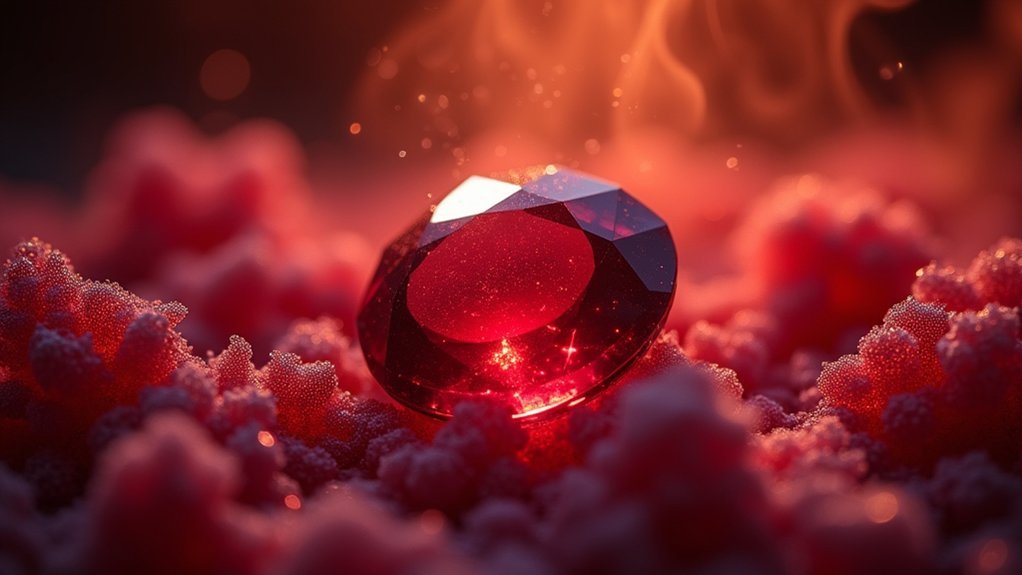
When you’re exploring ruby heat treatment, you’ll discover that this fundamental process involves heating gemstones to approximately 1800 degrees Fahrenheit in specialized crucibles to enhance their color and clarity.
The treatment works by dissolving rutile inclusions within the stone, improving both visual appeal and transparency without compromising natural durability.
Heat treatment dissolves internal rutile inclusions, enhancing ruby transparency and visual beauty while maintaining the gemstone’s natural structural integrity.
You’ll need specialized equipment like computer-controlled burnout furnaces to maintain consistent temperatures and controlled atmospheres throughout the process.
This Heat Treatment doesn’t involve foreign additives, preserving the ruby’s inherent strength and authenticity.
Understanding that most market rubies undergo some form of treatment is essential for evaluating gemstone quality.
Each stone’s characteristics determine the effectiveness of the process, requiring tailored approaches based on individual properties and desired outcomes for best results.
Essential Equipment for High-Temperature Ruby Treatment
Having grasped the fundamentals of ruby heat treatment, you’ll need to assemble the right equipment to achieve successful results at these extreme temperatures.
Standard home ovens won’t cut it for treating corundum gemstones. Treatment can improve ruby color and clarity, but only with specialized apparatus that reaches approximately 1800°F.
Essential equipment includes:
- Computer-controlled burnout furnaces for precise temperature regulation
- Platinum element ovens or alternative high-temperature heating systems
- Controlled atmosphere chambers with adjustable gas compositions
- Temperature monitoring devices for gradual heating changes
- Safety ventilation systems for hazardous gas management
You’ll find that specialized equipment guarantees consistent results while protecting your gemstones from thermal shock.
Preparing Rubies for Heat Treatment Process
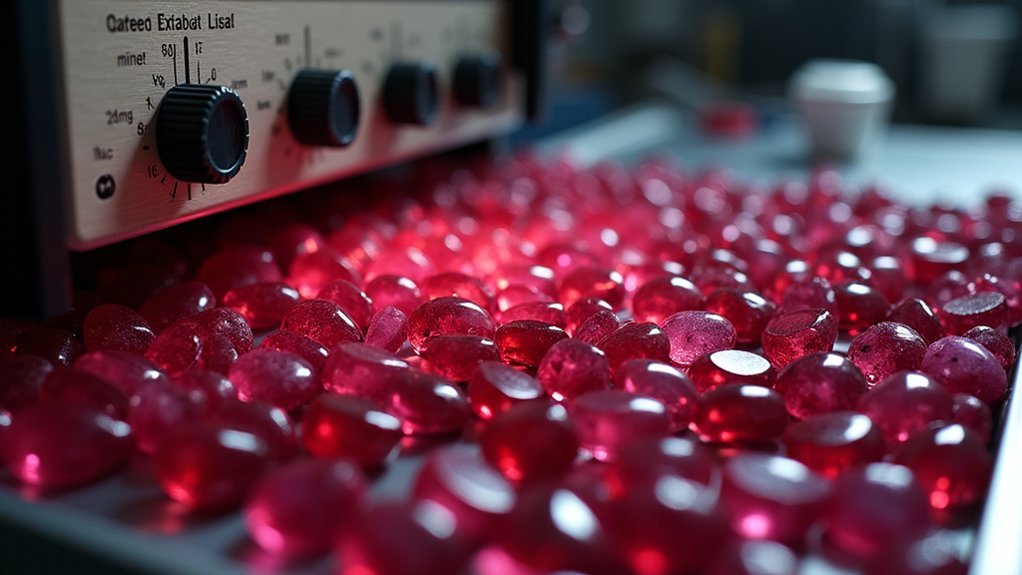
Before your rubies enter the furnace, you’ll need to conduct a thorough assessment of each stone’s unique characteristics.
Examine inclusions carefully, particularly rutile inclusions, as these will determine how your stones respond to heat treatment. Different inclusion types require different heating approaches to achieve ideal enhancement.
Evaluate each ruby’s color saturation and clarity to select the most appropriate treatment method.
Clean your cut stones meticulously before processing. Remove all surface contaminants, oils, and dirt using appropriate solvents, as these impurities can interfere with heating results.
Even microscopic residues can create unwanted reactions during treatment.
Document each stone’s pre-treatment condition with detailed photographs and notes. This baseline assessment helps you track improvements and adjust your heating parameters accordingly for consistent, professional results.
Temperature Requirements Above 1800°C for Corundum
Once you’ve properly prepared your rubies, the heating process demands temperatures exceeding 1800°C to achieve meaningful enhancement in corundum. This extreme heat threshold isn’t arbitrary—it’s the minimum required to dissolve rutile inclusions and improve clarity in both ruby and sapphire varieties.
- Place your stones in a ceramic crucible designed for high-temperature applications.
- Monitor temperature consistency carefully to prevent thermal shock damage.
- Maintain controlled atmosphere conditions to avoid oxidation during treatment.
- Expect the process to take several hours at sustained temperatures.
- Allow gradual cooling to room temperature over extended periods.
Whether you’re working with cut and polished specimens or rough material, maintaining these temperatures guarantees the rutile dissolves completely. This dissolution dramatically improves the red coloration and transparency that makes treated rubies and sapphires commercially valuable.
Controlling Atmosphere and Gas Composition
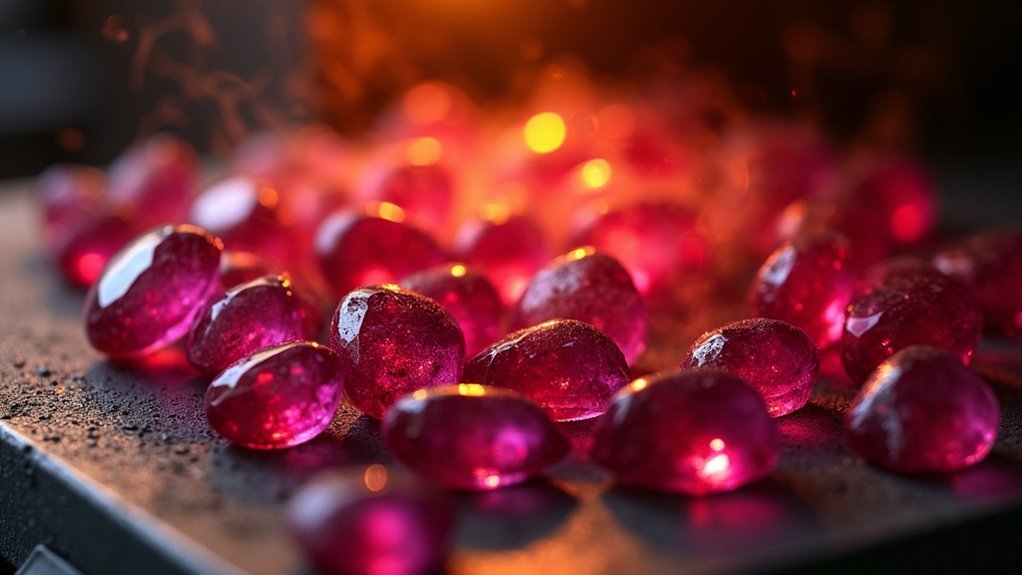
While achieving proper temperatures forms the foundation of ruby heat treatment, controlling the atmosphere and gas composition determines whether your enhancement efforts succeed or fail catastrophically.
Atmosphere control separates successful ruby enhancement from expensive disasters—proper gas composition matters more than perfect temperature alone.
You must purge your heating chamber of all impurities before introducing controlled gases like nitrogen or argon. These inert gases prevent oxidation that’ll destroy your ruby’s quality during the 1800-1900°C heating process.
You’ll need to experiment with different gas mixtures to achieve ideal color enhancement, but document every condition and outcome meticulously. Each gas composition produces different results, so detailed records become invaluable for future treatments.
Don’t forget safety precautions—toxic fumes release during treatment. You’ll require proper ventilation systems and protective equipment to avoid health hazards while monitoring your controlled atmosphere throughout the entire process.
Gradual Heating Techniques to Prevent Thermal Shock
You’ll need to implement precise temperature ramp control methods to safely bring your ruby from room temperature to the target 1800°C without causing thermal shock.
Managing your cooling rate is equally critical—you can’t simply turn off the furnace and expect good results.
Proper thermal stress prevention requires you to control both the heating and cooling phases with specialized equipment that maintains consistent temperature changes throughout the entire process.
Temperature Ramp Control Methods
When heating rubies, implementing proper temperature ramp control methods becomes your most critical defense against thermal shock damage.
You’ll need to establish a systematic approach that protects your gemstones throughout the entire heating process.
- Start at 300°C baseline temperature and increase in controlled 100°C increments
- Maintain heating rates between 50-100°C per hour to prevent rapid thermal expansion
- Hold each temperature stage for specified durations allowing complete thermal acclimation
- Use computer-controlled burnout furnaces for precise temperature management and consistency
- Cool gradually at 100°C per hour until reaching room temperature to avoid thermal stress
These controlled methods guarantee your rubies reach the target 1800°C treatment temperature safely, minimizing cracking risks while maintaining gemstone integrity throughout the heating cycle.
Cooling Rate Management
Proper cooling rate management protects your heat-treated rubies just as much as the initial heating phase does.
You’ll need to allow your rubies to cool slowly to room temperature after treatment to reduce internal stress and prevent thermal shock. Don’t rush this process – rapid temperature changes can cause catastrophic failure of your gemstone.
Use computer-controlled burnout furnaces to maintain consistent cooling rates and avoid abrupt thermal shifts.
Monitor the temperature carefully throughout the entire cooling phase, just as you did during heating. The controlled descent from your treatment temperature back to room temperature is critical for maintaining the structural integrity of your ruby while preserving the color enhancement you’ve achieved.
Thermal Stress Prevention
Thermal shock poses one of the greatest threats to ruby integrity during heat treatment, making gradual heating techniques absolutely essential for successful outcomes.
You’ll need to implement careful temperature control to prevent cracking and preserve your gemstone’s structural integrity.
- Start with lower temperature increments before reaching the target 1800°F (982°C) treatment level
- Use computer-controlled burnout furnaces for precise temperature adjustments and consistent heat application
- Preheat your oven before introducing rubies to help acclimatize stones to increased temperatures
- Monitor temperature closely throughout the heating process to prevent fluctuations that cause uneven expansion
- Allow slow cooling after treatment to prevent rapid temperature changes that lead to thermal shock
These controlled methods minimize thermal stress and maximize your heat treatment success rate.
Monitoring Duration and Temperature Maintenance
Since accurate temperature control determines the success of your ruby heat treatment, you’ll need to maintain temperatures around 1800°F (982°C) throughout the process.
Your heating duration varies considerably based on stone size and quality, ranging from several hours to a full day. Larger rubies require extended heating periods to guarantee uniform heat penetration reaches the core.
You must monitor your heating chamber’s atmospheric conditions continuously, as specific gases directly influence treatment outcomes.
Don’t rush the temperature increase—raise heat gradually in 100°F increments to prevent thermal shock damage.
Once you’ve reached target temperature, maintain steady conditions throughout the heating cycle.
Your patience during this phase pays off with superior results and reduced stone damage risk.
Proper Cooling Procedures to Avoid Fracturing
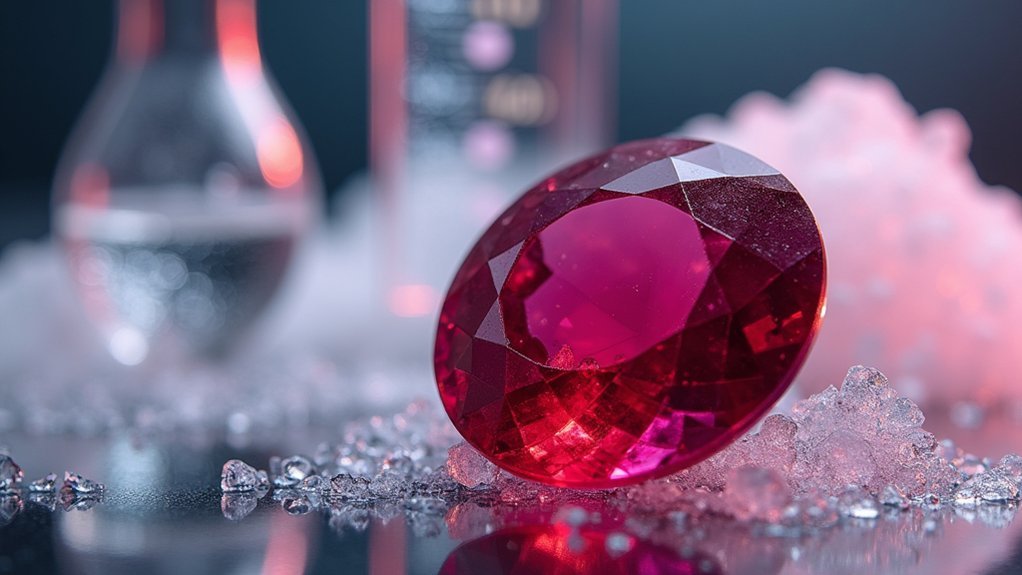
After maintaining your ruby at treatment temperature, you’ll need to implement gradual temperature reduction methods to prevent catastrophic fracturing.
Your controlled cooling chamber atmosphere must provide even heat distribution while you execute thermal shock prevention techniques.
The cooling process requires as much precision as the heating phase, since rapid temperature drops can destroy hours of careful work in seconds.
Gradual Temperature Reduction Methods
When you’ve reached peak treatment temperatures, the cooling process becomes just as critical as the heating phase itself.
You’ll need to implement controlled temperature reduction to prevent thermal shock and fracturing in your rubies.
Your gradual cooling strategy should include:
- Temperature increments: Reduce heat in 50-100°C steps, especially after treatments above 1800°C
- Programmable furnace: Use equipment with automated cooling cycles for consistent temperature control
- Extended cooling period: Keep rubies in the heated environment until they reach approximately 500°C
- Continuous monitoring: Track temperature throughout the cooling phase to prevent rapid drops
- Room temperature transfer: Only move rubies to ambient conditions after reaching the 500°C threshold
This methodical approach preserves your ruby’s integrity and clarity while minimizing stress-related damage.
Controlled Cooling Chamber Atmosphere
While temperature control forms the foundation of successful ruby treatment, the atmospheric conditions within your cooling chamber play an equally significant role in preventing fractures.
You’ll need to maintain consistent pressure and temperature through a stable atmosphere that prevents thermal shock. Monitor your chamber’s gas composition carefully, as variations can compromise your ruby’s structural integrity during cooling.
Install computer-controlled systems to enhance your cooling procedures’ effectiveness. These advanced technologies guarantee ideal atmospheric conditions while maintaining the vital 100°C per hour cooling rate.
Your cooling chamber’s stable environment reduces cracking risks by eliminating pressure fluctuations. Don’t overlook atmospheric monitoring—it’s essential for preserving your treated rubies’ quality and preventing costly fractures that could ruin your gemstone treatment investment.
Thermal Shock Prevention Techniques
Though atmospheric control sets the stage for successful cooling, implementing proper thermal shock prevention techniques guarantees your rubies won’t crack during temperature alterations.
You’ll need to manage temperature shifts carefully since rapid fluctuations cause devastating thermal shock.
Here’s how you’ll protect your gemstones:
- Use step-down cooling – Reduce temperature incrementally rather than all at once
- Employ controlled cooling environments – Utilize insulated furnaces or dedicated slow-cooling chambers
- Allow extended room temperature rest – Let rubies cool naturally for extended periods before handling
- Monitor the process closely – Track temperature changes throughout the entire cooling phase
- Avoid cold exposure – Keep rubies away from cold air or surfaces immediately after heating
These techniques minimize thermal stress and prevent fracturing that destroys valuable rubies.
Evaluating Results and Color Enhancement Outcomes
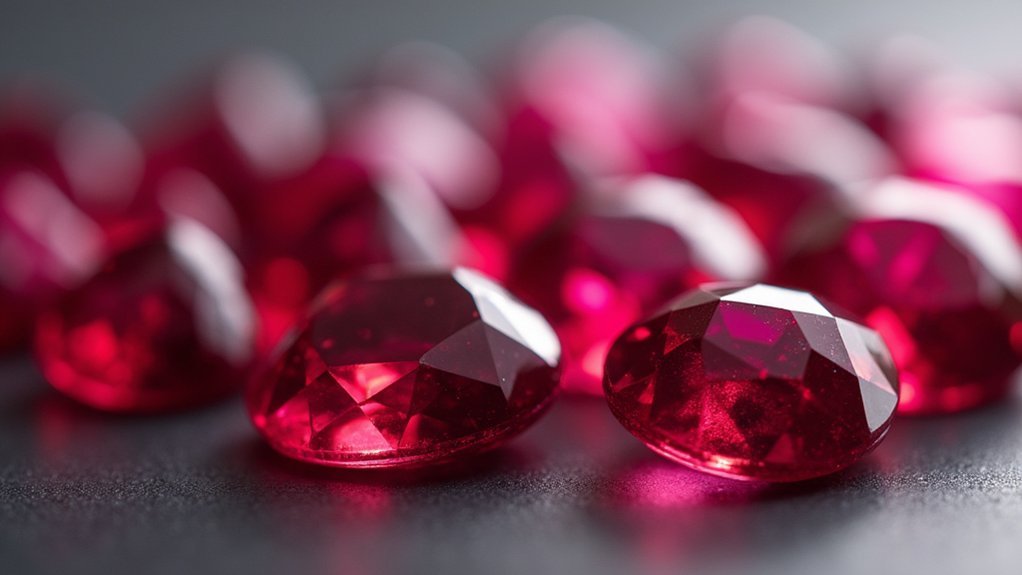
Most ruby heat treatment procedures produce dramatic transformations that you’ll need to evaluate systematically once the stones have cooled completely.
You’ll notice significant improvements in your ruby’s red hue saturation and brightness, making it considerably more marketable.
Examine the stone carefully for color zoning patterns that might’ve emerged during treatment, as these indicate uneven heating distribution.
Check how inclusions have changed—dissolved rutile needles should’ve enhanced overall clarity.
Compare the treated ruby’s color intensity against your pre-treatment documentation to measure enhancement effectiveness.
Look for any unwanted color shifts or damage that could’ve occurred from oxidation or thermal stress.
Document these results thoroughly to refine your future heat treatment parameters and achieve consistent, ideal outcomes.
Safety Precautions for High-Temperature Ruby Treatment
You’ll need proper protective equipment before attempting any high-temperature ruby treatment to prevent serious burns and eye injuries.
Heat-resistant gloves and safety goggles aren’t optional—they’re essential barriers against the extreme temperatures you’ll be working with.
You must also address toxic gas mitigation by ensuring adequate ventilation in your workspace, as harmful fumes can accumulate during the heating process.
Essential Protective Equipment
When working with the extreme temperatures required for ruby heat treatment, your safety depends entirely on using proper protective equipment.
You’ll need thorough protection from head to toe to prevent serious injury from molten materials and toxic fumes.
Essential protective equipment includes:
- Heat-resistant gloves and face shields – Protect against burns and splashes from molten ruby materials
- Well-ventilated workspace or fume hood – Prevents inhalation of dangerous gases released during high-temperature treatments
- Heat-resistant aprons and safety footwear – Guards against accidental spills and equipment failures
- High-temperature rated equipment – Guarantees ovens and crucibles can handle extreme heat safely
- Chemical fire extinguisher – Provides immediate response capability for unexpected hazards
Regular equipment inspections prevent accidents before they occur.
Toxic Gas Mitigation
High-temperature ruby treatment releases potentially dangerous gases that demand immediate attention to ventilation systems.
You’ll need proper workspace ventilation to mitigate toxic gas risks from heated materials, especially when using flux or additives. Install a fume hood or exhaust system to considerably reduce your exposure to harmful fumes during heating processes.
You must wear personal protective equipment including respirators and gloves to prevent inhaling toxic gases and avoid skin contact with hazardous materials.
Regularly monitor air quality in your treatment area using gas detection systems that’ll alert you to harmful gas presence during heating.
Implement strict safety protocols with proper training in handling and disposing hazardous materials.
This prevents accidents and guarantees you maintain a safe working environment throughout ruby heat treatment procedures.
Frequently Asked Questions
How Do You Heat Treat Rubies?
You’ll heat rubies to 1800°F in specialized computer-controlled furnaces with gradual temperature changes. You must monitor the atmosphere carefully, take safety precautions against toxic gases, and avoid thermal shock to preserve structural integrity.
Are Heat Treated Rubies Less Valuable?
Heat-treated rubies aren’t less valuable since they comprise 99% of the market. You’ll find them more affordable than untreated stones while maintaining similar durability and enhanced visual appeal that buyers desire.
What Happens When a Ruby Is Heated?
When you heat a ruby, you’re dissolving rutile inclusions that cloud the stone. You’ll see improved clarity and more vibrant red color as the internal structure changes, creating a uniform hue.
How to Activate Ruby Gemstone?
You’ll activate your ruby gemstone by heating it to 1800°F in a computer-controlled furnace. Gradually increase temperature to prevent thermal shock while maintaining proper atmosphere control throughout the process.
In Summary
You’ve now mastered the complex process of ruby heat treatment. Remember, you’ll achieve the best results by maintaining precise temperatures above 1800°C, controlling your atmosphere carefully, and cooling slowly to prevent fractures. Don’t rush the process—patience yields stunning color enhancement. Always prioritize safety when working with extreme temperatures. With practice, you’ll consistently transform rough rubies into brilliant gemstones that showcase their natural beauty and maximize their market value.

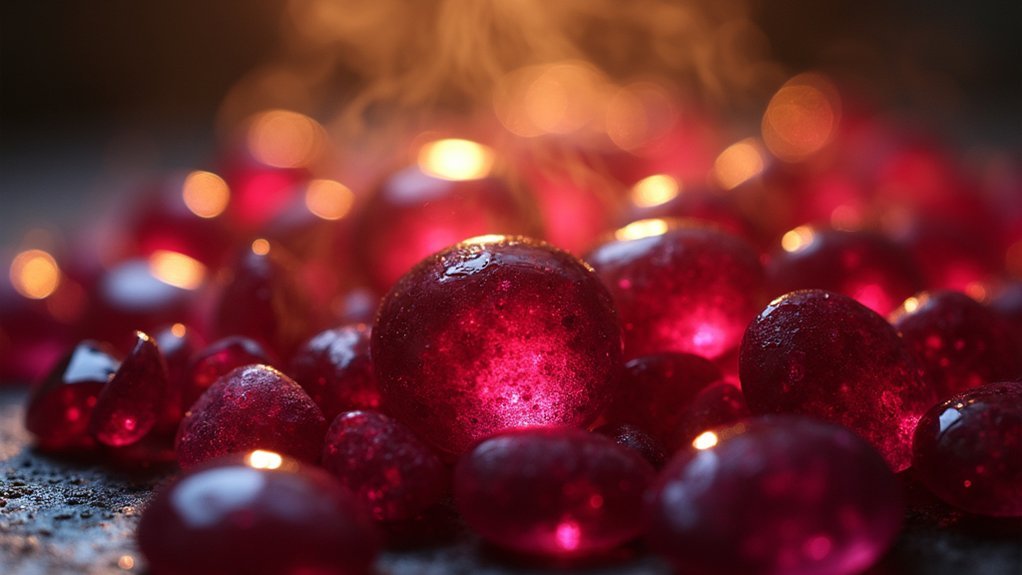
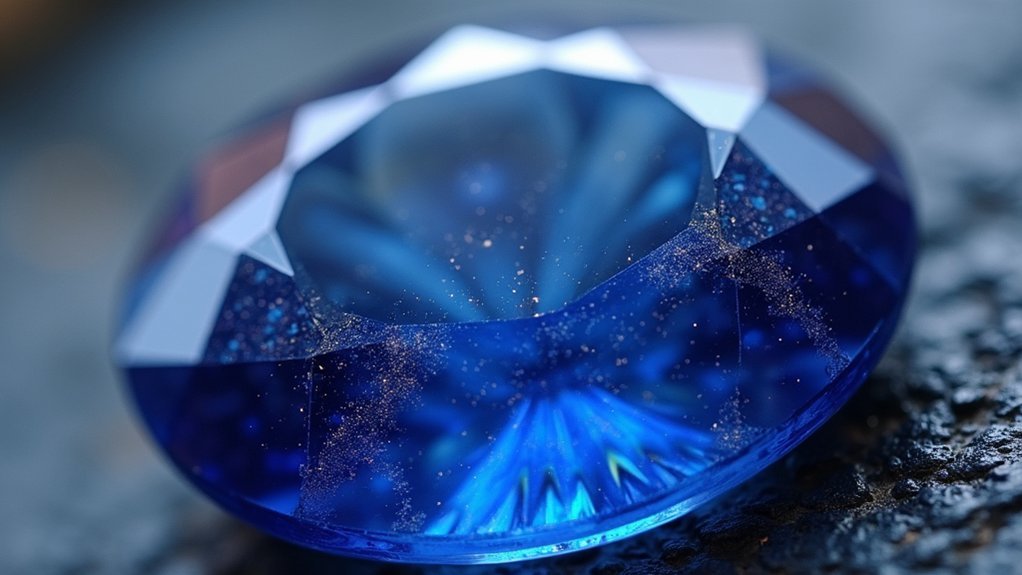
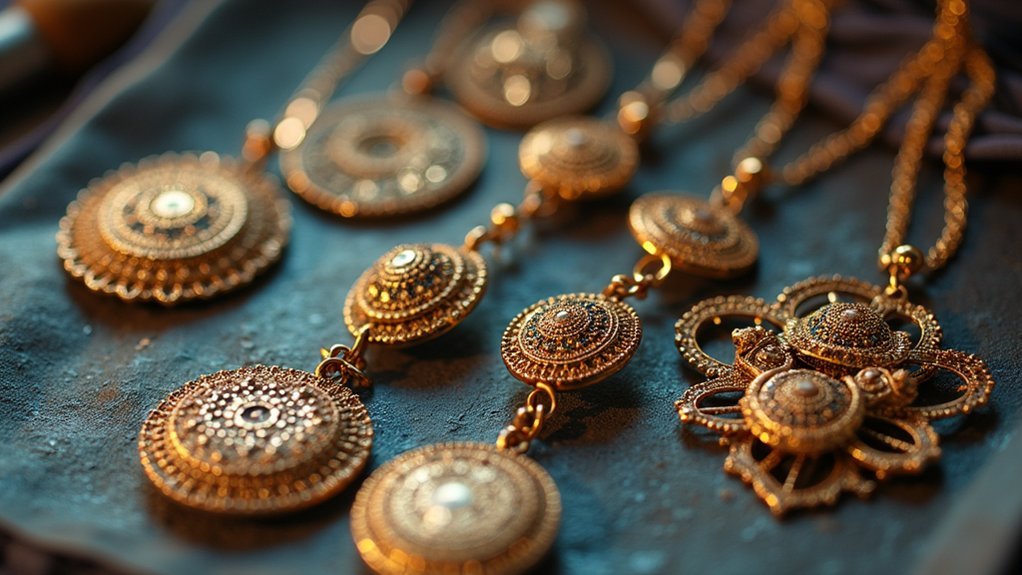
Leave a Reply